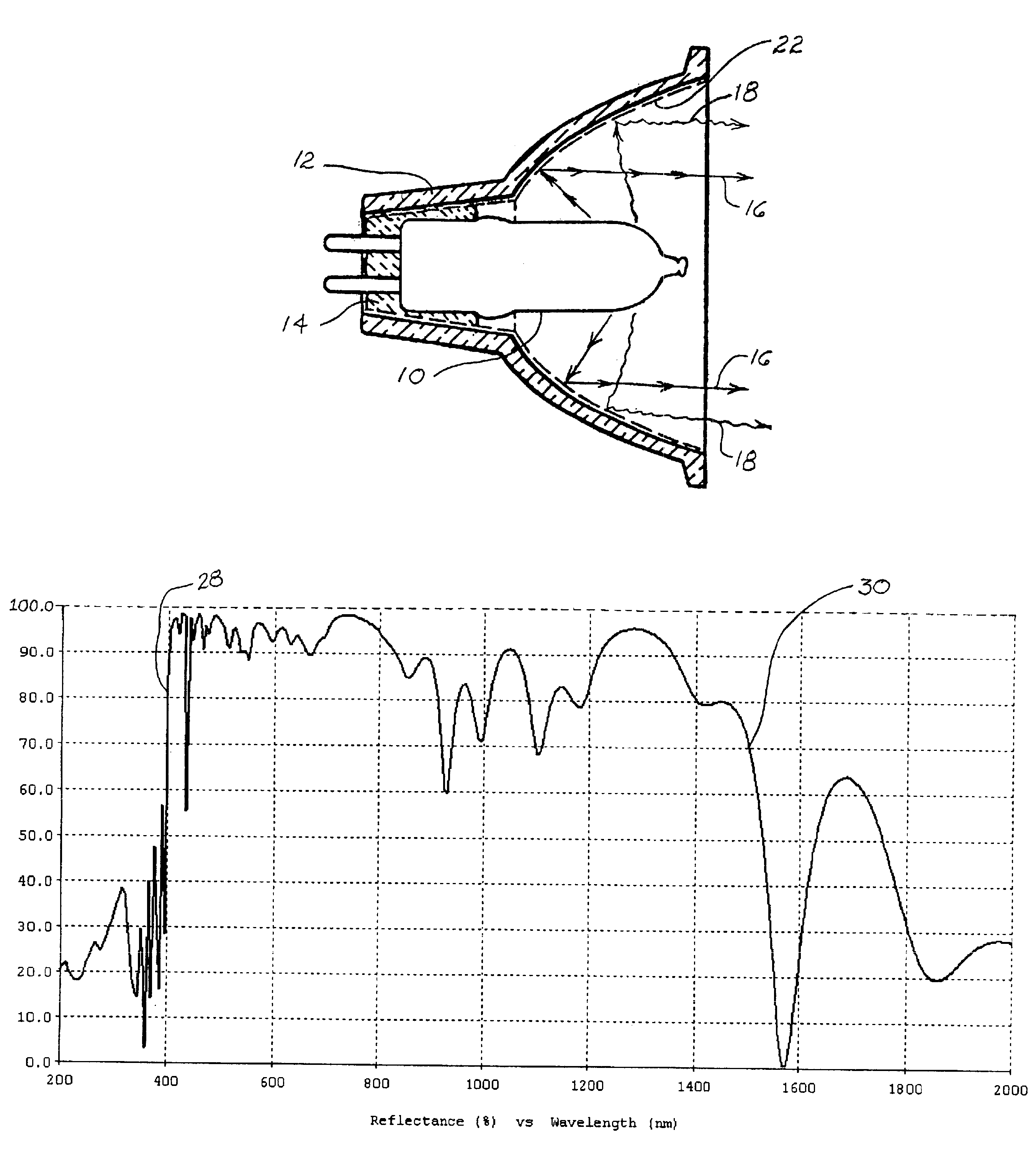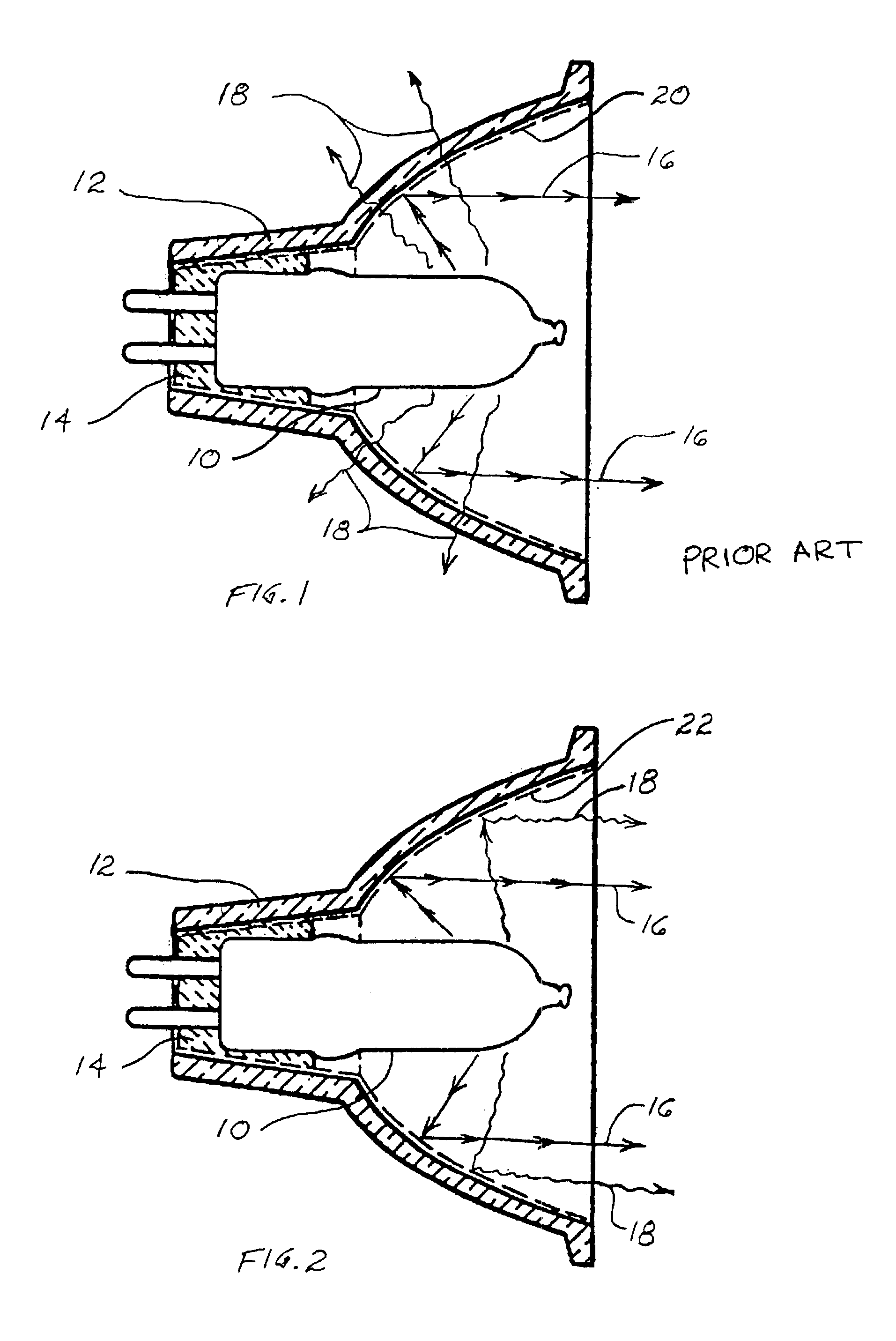Broad spectrum reflective coating for an electric lamp
a reflective coating and broad spectrum technology, applied in the direction of optical elements, lighting and heating apparatus, instruments, etc., can solve the problems of short-lived oxidation-susceptible coatings, reducing their effectiveness, and economically impractical coatings utilizing expensive elements
- Summary
- Abstract
- Description
- Claims
- Application Information
AI Technical Summary
Benefits of technology
Problems solved by technology
Method used
Image
Examples
example 1
Prior Art Coating
FIG. 4 is a plot illustrating the spectrum of wavelengths reflected versus the percentage of each wavelength reflected by a typical dichroic coating of the prior art. Twenty-six (26) layers comprise the structure of the coating. The physical thickness of each layer in Angstroms (.ANG.) is shown in Table 1 below, where L is a low refractive index material and H is a high refractive index material. Layer 1 is the layer closest to the substrate.
[t2]
For the majority of the visible portion of the spectrum, commencing with a lower end of high reflectance 25, at a wavelength of about 400 nm, and ending at a higher end of high reflectance 26, at a wavelength of just over 800 nm, a coating of the prior art exhibits a spectral high reflectance in the approximate range of 90% or higher. Thus, the spectral high reflectance of a typical prior art coating is about 90% from approximately 400 nm to just over 800 nm.
The portion of the electromagnetic spectrum that includes infrared ...
example 2
Exemplary Embodiment of the Present Invention
FIG. 5 is a plot showing the spectrum of wavelengths reflected versus the percentage of each wavelength reflected by an exemplary embodiment at a normal angle of incidence. The materials used for this embodiment are alternating layers of titanium dioxide (TiO.sub.2) and silicon dioxide (SiO.sub.2). The titanium dioxide is the high refractive index material and the silicon dioxide is the low refractive index material. The coating is optimized at a target angle of incidence of 0.degree. and includes wavelengths extending from 400 nm to 1,500 nm, with wavelengths from 400 nm to 800 nm receiving a higher weighting than those over 800 nm. The substrate material is glass.
Thirty-nine (39) alternating layers of TiO.sub.2 and SiO.sub.2 comprise the dichroic structure of the coating. The physical thickness in Angstroms (.ANG.) of each layer is shown in Table 2 below. Layer 1 is the layer closest to the glass substrate.
[t1]
The dichroic structure of ...
example 3
A Second Exemplary Embodiment of the Present Invention
FIG. 7 is a plot showing the spectrum of wavelengths reflected versus the percentage of each wavelength reflected by another exemplary embodiment at a normal angle of incidence. The materials used for this embodiment are alternating layers of titanium dioxide (TiO.sub.2) and silicon dioxide (SiO.sub.2). The titanium dioxide is the high refractive index material and the silicon dioxide is the low refractive index material. The coating is optimized at a target angle of incidence of 0.degree. and includes wavelengths extending from 400 nm to 1,200 nm, with wavelengths from 400 nm to 800 nm receiving a higher weighting than those over 800 nm. The substrate material is glass.
Twenty-six (26) alternating layers of TiO.sub.2 and SiO.sub.2 comprise the dichroic structure of the coating. The physical thickness of each layer in Angstroms (.ANG.) is shown in Table 3 below. Layer 1 is the layer closest to the glass substrate.
[t4]
The dichroic ...
PUM
| Property | Measurement | Unit |
|---|---|---|
| Fraction | aaaaa | aaaaa |
| Fraction | aaaaa | aaaaa |
| Nanoscale particle size | aaaaa | aaaaa |
Abstract
Description
Claims
Application Information
 Login to View More
Login to View More - R&D
- Intellectual Property
- Life Sciences
- Materials
- Tech Scout
- Unparalleled Data Quality
- Higher Quality Content
- 60% Fewer Hallucinations
Browse by: Latest US Patents, China's latest patents, Technical Efficacy Thesaurus, Application Domain, Technology Topic, Popular Technical Reports.
© 2025 PatSnap. All rights reserved.Legal|Privacy policy|Modern Slavery Act Transparency Statement|Sitemap|About US| Contact US: help@patsnap.com



